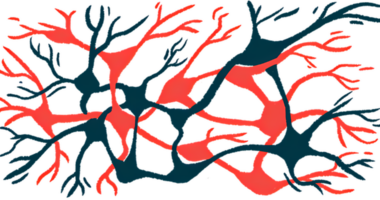Black phosphorus seen to ease Parkinson’s symptoms in rat model
Its anti-inflammatory potential may lie in effects on microglia in the brain

Tiny bubbles containing a flaky form of phosphorus, called black phosphorus, delivered to the brain may help to control overactive microglia — the brain’s resident immune cells — that drive the inflammation damaging to nerve cells in Parkinson’s disease, scientists in China report.
In a study in a rat model of Parkinson’s, delivering those microbubbles with the aid of low-frequency focused ultrasound waves eased disease symptoms, helping treated rats to swim faster through a water maze and run longer on a rotating rod.
These gains, the scientists reported, may come through black phosphorus allowing microglia to take on an anti-inflammatory role.
The study, “Black Phosphorus Microbubbles Combined with Ultrasound for Treating Parkinson’s Disease,” was published in Advanced Therapeutics.
Black phosphorus may dampen inflammation via effects on microglia
Parkinson’s is caused by the loss of dopamine-producing neurons, or nerve cells, and marked by the buildup of toxic protein clumps that cause microglia to become overly reactive and mount too strong a response. A result is lasting inflammation and oxidative stress that damages nerve cells, leading to disease motor and nonmotor symptoms.
Black phosphorus is composed of ultra thin layers of phosphorus atoms arranged in a honeycomb pattern. Earlier work showed that black phosphorus can soak up light or sound waves and turn them into heat, which can be used to open the blood-brain barrier. This semipermeable membrane prevents harmful substances and toxins from entering the brain, but it also prevents access to medications that need to act on the brain.
While being tested as a vehicle to carry and deliver medications to specific sites in the body, black phosphorus showed an ability to reduce inflammation and the harmful oxygen-containing molecules, called reactive oxygen species, that cause oxidative stress.
A team of researchers at Shenzhen Peking University used ultrasound waves — high-energy sound waves — combined with black phosphorus microbubbles to release heat that opens the blood-brain barrier, allowing black phosphorus to enter and have effect on the brain.
Researchers made two types of microbubbles: one containing quantum dots (tiny spheres) and the other nanosheets (very thin sheets) of black phosphorus. Both were wrapped with a fat-like material. Because black phosphorus is hydrophobic, meaning that it doesn’t mix with water, it was tucked into those fatty wrappings.
The microbubbles were injected into the tail vein of a rat, and focused ultrasound then was applied for 1.5 minutes to the right side of the rat’s brain. Brain tissue samples were collected 24 hours later for examination under a microscope.
Both quantum dots and nanosheets crossed the blood-brain barrier to enter the brain, the team reported. Brain cells containing quantum dots appeared normal in shape and structure, but those containing nanosheets appeared misshapen and somehow damaged. Reactive oxygen species were observed, and there were fewer synapses, or interactions between nerve cells.
Treated rats did better on skill tests than did untreated rats
Researchers then tested the effects of black phosphorus microbubbles in a rat model of Parkinson’s disease.
Microbubbles were injected at a low dose into animal tail veins daily for two weeks, and the blood-brain barrier was opened every three days using focused ultrasound. Tests were performed one day before and three days after the two-week treatment.
In a water maze test of spatial learning and memory, Parkinson’s model rats initially took longer than healthy rats to reach a submerged platform. However, those treated with either quantum dots or nanosheets swam faster toward the platform than did untreated model rats. Use of quantum dots microbubbles appeared to have the greatest effect.
“These results suggest that treatment was effective in slowing down the learning and memory impairments in rats,” the researchers wrote.
Parkinson’s model rats placed on a rotarod, or rotating rod, also fell off faster than did healthy rats. While treatment with black phosphorus nanosheets appeared to bring no benefits, quantum dots helped rats to stay longer on the rotarod, suggesting they “improved motor symptoms of [Parkinson’s],” the researchers wrote.
While model rats showed a loss of dopamine-producing nerve cells — those responsible for motor control — black phosphorus quantum dots and nanosheets protected against this loss. Those treated with quantum dots also showed less oxidative stress and inflammation.
Black phosphorus quantum dots added to lab-grown microglia prompted the cells to extend processes and connect, while nanosheets caused cells to enlarge with blurred edges, the scientists reported. Moreover, quantum dots increased the activity of anti-inflammatory genes, whereas nanosheets made pro-inflammatory genes more active.
In neurodegenerative diseases like Parkinson’s, microglia shift from an anti-inflammatory to a pro-inflammatory profile, a process called M2 to M1 polarization that leads to neuroinflammation. Black phosphorus quantum dots induced M2 polarization, making microglia take on an anti-inflammatory role that might explain their protective effects.
Researchers also found that these black phosphorus microbubbles may delay Parkinson’s progression by regulating intestinal flora, which is thought to be closely related to the disease’s occurrence and development.
While more research is needed into this approach’s potential safety and effectiveness for patients, combining black phosphorus quantum dots with focused ultrasound “may be a promising option for the clinical treatment of [Parkinson’s],” the researchers concluded.







